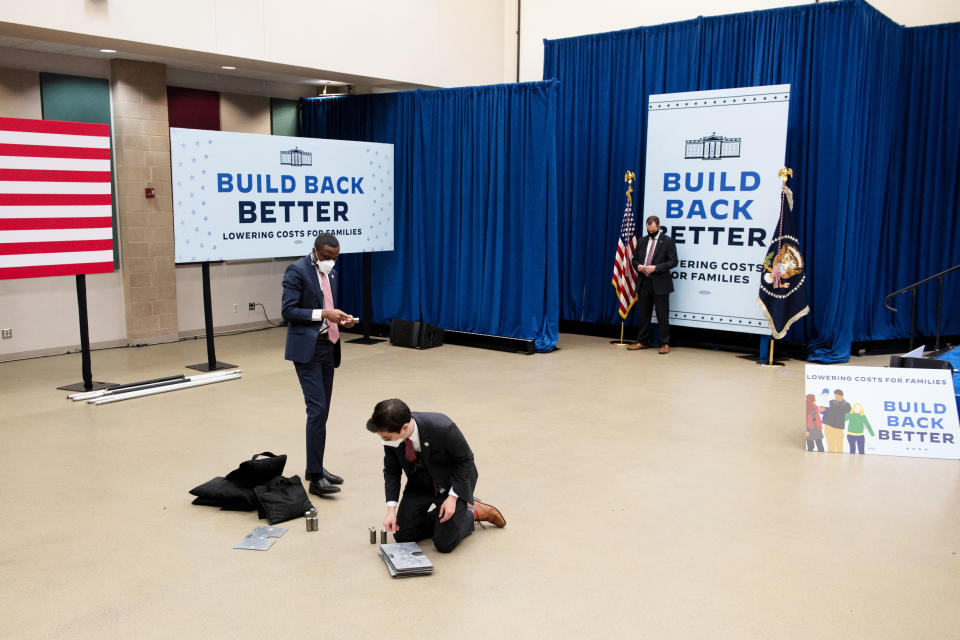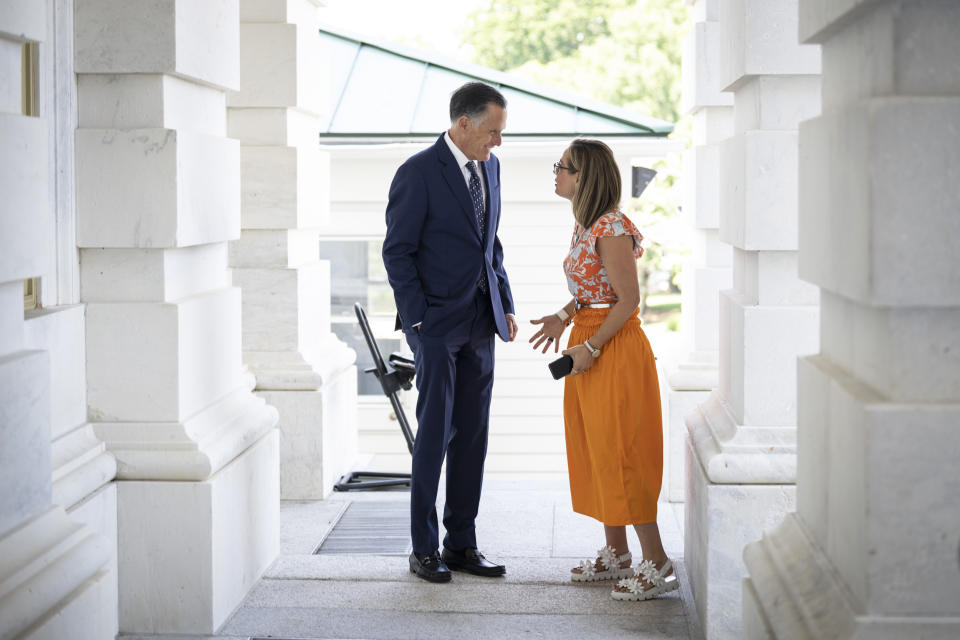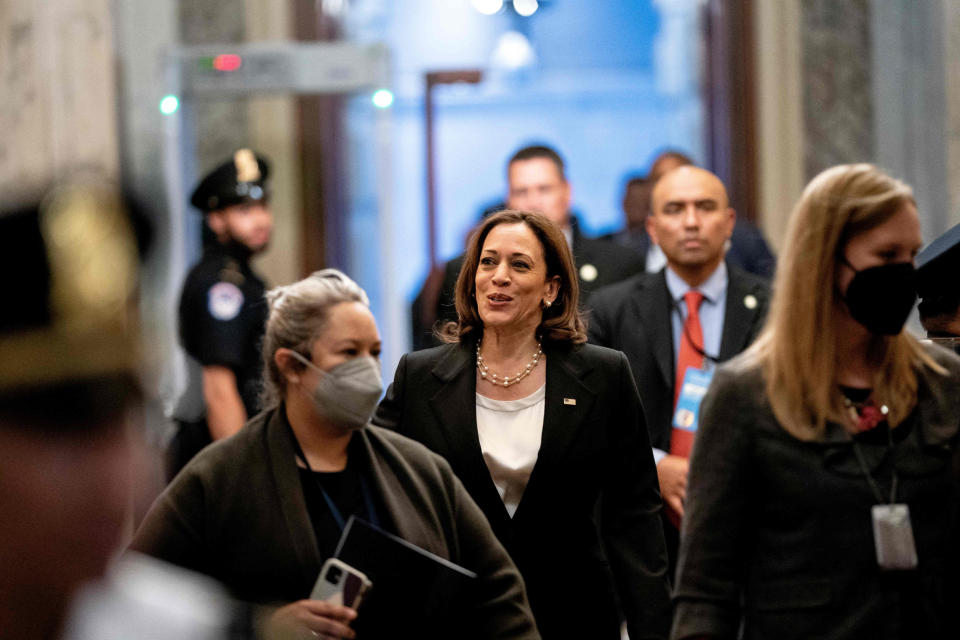How Democrats’ surprise climate and health care bill came together after months of setbacks and reversals
- Oops!Something went wrong.Please try again later.
- Oops!Something went wrong.Please try again later.
- Oops!Something went wrong.Please try again later.
- Oops!Something went wrong.Please try again later.
WASHINGTON — Like many others in this town, Sen. Kyrsten Sinema first saw the news on Twitter.
Her fellow centrist Democrat, Sen. Joe Manchin of West Virginia, had cut a surprise deal with Majority Leader Chuck Schumer on a sweeping climate, health care and tax package that most people in their party had left for dead.
Sinema was blindsided, said a source close to the senator. She hadn’t been included in the secret Manchin-Schumer talks; she hadn’t been consulted before the agreement was announced either.
But the Arizona Democrat wasn’t upset at being left out. She could count to 50 and knew that Manchin and Schumer would need to come to her eventually to get her vote in the evenly divided Senate where Republicans would surely unite in opposition.
Democrats had toiled for a year and a half, trying to get Manchin and Sinema on board with President Joe Biden’s signature domestic agenda. Build Back Better would remake the U.S. economy and social safety net by investing trillions in child and senior care, universal preschool and free community college, in addition to combating climate change and lowering the cost of health care.
When Manchin abruptly broke off talks with Biden and the White House in December 2021, declaring that he couldn’t vote for a slimmer, House-passed $1.7 trillion package, Democrats were furious, then resigned themselves to the fact that Build Back Better would probably never become law.
They were right. The climate, health and tax package passed by the House on Friday and sent to Biden’s desk is dramatically scaled down from the president’s original vision, which had drawn comparisons to FDR’s New Deal. But it’s also much more robust than the pared-back health care provisions that Manchin signed off on just weeks ago. The bill, on its way to becoming law, represents the largest U.S. investment ever to fight climate change.
“The members that were directly involved in the negotiations — it shows their strength,” Sen. Ben Ray Lujan of New Mexico said in an interview.
This is an account of how a flurry of last-minute, behind-the-scenes deal making this summer handed Biden and the Democrats their most significant legislative accomplishment since seizing all the levers of power in Washington in January 2021. It is pieced together from interviews with Senate and House lawmakers, senior Democratic aides and White House officials.
Manchin goes bigger
After the collapse of Build Back Better, the left was torn over how to proceed. Rep. Pramila Jayapal, the chair of the Congressional Progressive Caucus, began to give up hope that Manchin would get on board, and started to refocus her attention on executive actions. Rep. Ro Khanna of California, however, stayed in touch with Manchin.

Beginning in January, the two spoke about twice a month. Khanna's message to Manchin was simple: As long as you agree to at least $300 billion in climate funding, the House will be with you.
“I told him, Senator Manchin, as long as that number is big and it’s inclusive of electric vehicles and solar and wind — as long as that’s there I can work with the groups and we can get the progressives,” Khanna said in an interview.
Most Democrats thought the prospects for any kind of deal were long dead. But on July 14, with the August congressional recess fast approaching, Manchin gave Schumer an ultimatum: Pass two key health care provisions right now, or punt the issue to September to try to broaden the package with climate and tax policies.
If they waited, there was a strong possibility nothing would get done. Acting now would at least give Democrats a win on lowering prescription drug prices and extending Affordable Care Act subsidies — no small feat — before the November midterms. Schumer briefed Biden, his old Senate colleague, who agreed they needed to take the bird in the hand. The president issued a statement that Friday urging Democrats to quickly pass it.
When the following Monday rolled around, Manchin's staff approached Schumer's staff with a new proposal: Manchin might agree to pass a broader package in August, not September. The offer was very close to where Schumer and Manchin had left things — less taxes but still a good program on climate.

Schumer and his aides were shocked by Manchin’s reversal. The gears were now in motion for a bigger deal.
Manchin and Schumer privately met that Monday afternoon in the basement of the Capitol — out of view of their Senate colleagues and nosy reporters — to flesh out the details. The conference room had no windows but featured a mural of the U.S. Capitol. Schumer had never been in the room before.
“What a beautiful office. Is it mine?” Schumer said. In fact, it was one of the many rooms and spaces in the building that the majority leader controlled.
The two senators agreed on a timeline — to pass the bill before the Senate’s summer recess began in the first week of August — but they didn’t nail down the policy details. They shook hands and agreed that their staff members would keep working.
Although Manchin tested positive for Covid-19 on July 24, their talks continued virtually and by phone, with Schumer relying on his secret weapon: his outdated flip phone.
“This is my secret to success,” he would later say.
We have a deal?
By the early afternoon of July 27, Schumer and Manchin hopped on what would be a pivotal video conference. Their staff had just resolved a last-minute Joint Committee on Taxation issue, and they had agreed on a top-line figure for energy.
The Zoom ended with a deal and a “virtual handshake” on a roughly $700 billion package. It called for $370 billion in climate and energy investments; allowed Medicare to negotiate prescription drug prices for the first time; extended Obamacare subsidies for three years; included $80 billion to beef up IRS enforcement; and added tax changes, including a 15% minimum tax for big corporations.
On top of that, it would cut the deficit by more than $300 billion. Manchin named it the Inflation Reduction Act — a nod to what he said was the number one issue facing American families.
Manchin and Schumer spent the rest of the day briefing both the White House and other Hill leaders. At 3:50 p.m., Schumer made the short walk to House Speaker Nancy Pelosi's office and met one-on-one with Pelosi for about 20 minutes. Schumer briefed White House officials, who in turn called Manchin to offer their support.
At about 4:40 p.m., Manchin issued his statement announcing the deal, sending Capitol Hill, K Street and the rest of Washington into a frenzy. In the middle of her weekly “Crescendo” meeting with the leaders of all the party’s caucuses, a staff member quietly slipped Pelosi a note: Manchin had just announced the deal. The speaker immediately shared the news with participants in the room, including Jayapal and Rep. Suzan DelBene, chair of the New Democrat Coalition.
In the House, progressives, who had hurled insults at Manchin all year, rejoiced at the news, while also prodding reporters for specific details about the critical climate component. “You lifted up my spirits,” Rep. Jamaal Bowman, a progressive from New York, told a reporter when informed about the deal.
Jayapal, skeptical at first, watched Manchin embrace and sell the package on the air, surprised and impressed by his commitment. “I’m very glad that we are now totally unified,” the Washington Democrat said in an interview. “I’ve watched him on TV defending the bill, and I think he’s doing a great job.”
To Manchin, it was obvious he had to fully embrace the bill. No half measures. “He knows it will be hung around his neck if he runs again in 2024. So he knew he had to sell it,” said a person familiar with Manchin’s thinking. “He owns this deal.”
Staff members for Schumer and Manchin worked together to release a joint statement at 5:30 p.m., formally announcing the details of the agreement. The leader then spent the rest of the evening briefing Senate Democrats and key House members, as well as numerous environmental groups, to win their support.
“Our strategy was to give people space,” said one senior Democratic aide.

Biden's sign-off
The White House was giving Manchin space too. After Biden’s public breakup with Manchin in December, the White House had instituted a “Fight Club” mentality about any ongoing congressional negotiations — they just refused to talk about talks.
On July 15, as Manchin and Schumer worked to salvage a slimmed-down package, Biden himself seemed to wash his hands of it. “I didn’t negotiate with Joe Manchin. I have no idea,” Biden told NBC’s Peter Alexander in Saudi Arabia when asked if Manchin had been negotiating in good faith.
Behind the scenes, the White House was being kept in the loop. Biden had instructed one of his chief lieutenants, Steve Ricchetti, to maintain a direct, open channel with Manchin for months, while Brian Deese, director of the National Economic Council, kept staff-level conversations going with Manchin’s office. And Ron Klain, White House of Staff, was in regular contact with Schumer.
But unlike in 2021, there were no Biden visits to the Hill to rally Democrats, and there was no White House entourage shuttling between offices, acting as a go-between.
“Because of the way 2021 ended … it probably made it difficult when they were re-engaging to bring in the White House too heavily,” said one Democratic senator, who said he didn’t see any White House presence on the Hill. “It didn’t seem like there was a lot of deep involvement. That doesn’t mean there was not some engagement, but it doesn’t mean there was like a three-way conversation.”
A positive Covid-19 test kept Biden sidelined as talks headed into the home stretch. On July 27, after Biden tested negative and re-emerged from isolation the first time, he was briefed directly by his top advisers on where that final deal stood, and made calls to Manchin and Schumer that night.
“Biden checked in a few times,” said a Democratic source familiar with the talks, “and he deserves credit for trusting the process and knowing how the Senate works.”
Spotlight shifts to Sinema
With Manchin on board, the spotlight turned to the other enigmatic Democrat, Sinema. For a week, she played a game of cat and mouse with the press, refusing to say whether she would back the deal. She also didn’t make it easy for Manchin, who was trying to find time to talk with her about the package.
Manchin found her during a vote series when Sinema was presiding in the Senate president’s chair. He climbed up onto the dais, sporting a mask and gray suit, and spoke with her for about 15 minutes.
For the better part of a year, Sinema had made her red lines very clear with Schumer, Manchin and other colleagues. She had consistently opposed closing the carried interest loophole, which lets private equity managers pay a much lower tax rate on their earnings than most people do on ordinary income. It later came out at her insistence.
“Senator Sinema said she would not vote for the bill, not even move to proceed unless we took it out,” Schumer told reporters last week. “So we had no choice.”
Sinema was incredulous that Democrats’ historic climate bill didn’t include any drought prevention money for drought- and wildfire-prone places like her home state of Arizona. She would have to resolve that issue later with help from Sens. Catherine Cortez Masto of Nevada and Michael Bennet of Colorado, and other Western-state Democrats.
A crucial day
Aug. 4, a Thursday, was a crucial day: Schumer wanted to announce that all 50 of his Democrats were on board ahead of a possible weekend session; Sinema was the lone holdout. But her attention was divided. That afternoon, she was a blur of activity, standing in the well of the Senate floor, whipping Republicans to support the confirmation of Arizona attorney Roopali Desai, her good friend whom Biden had nominated for the powerful 9th U.S. Circuit Court of Appeals.
She’s often regarded as one of Republicans’ favorite Democrats in the upper chamber — she did deals on infrastructure and guns with the GOP this cycle — so it was here that she was going to burn some of her political capital. When she saw Sen. Cynthia Lummis, a staunch conservative Republican, vote no on Desai, Sinema jumped in and asked if Lummis would reconsider her vote.
“This woman is a very dear friend; she is not an ideologue. She will be a very dedicated, smart judge,” Sinema told Lummis, the Wyoming Republican recalled to NBC News. Lummis expressed concern about the liberal 9th Circuit, but Sinema’s personal appeal ultimately won her over.
“Senator Sinema vouched for this woman, so I changed my vote,” Lummis said.
Moments later, Sinema, 46, a triathlete and iron woman competitor, sprinted out the doors of the Capitol yelling: “Has anyone seen Mitt?” She found Sen. Mitt Romney and escorted the Utah Republican back onto the Senate floor, and he too voted yes for Desai. Desai was confirmed 67-29, with 19 Republicans voting yes.

But Republicans would not be happy about what Sinema was doing out of view of reporters and photographers. That afternoon and evening, she was holed up in her tiny, windowless hideaway office, in the bowels of the Senate. A man unknown to most of Washington but well-known to Sinema was shuttling in and out of the room. It was Gerry Petrella, Schumer’s policy director, and they were hammering out the final details of a deal to win her vote.
She trusted him. They had worked closely together on paring back Biden’s original $3.5 trillion Build Back Better package, and he was there when she and Republicans did a deal on a $1 trillion infrastructure bill.
As she and Petrella made good progress, Schumer summoned Sinema to his office to iron out the final details and seal the deal.
About 7 p.m. Sinema arrived. They met for about 30 minutes and sealed the deal with a handshake. The carried interest provision was out, and she would get billions in drought resiliency funding. She wanted $5 billion for the West; Manchin would only agree to $4 billion.
“They don’t have droughts in West Virginia,” quipped one Democratic senator.
To make up revenue loss from the elimination of carried interest, Schumer went with a 1% excise tax on stock buybacks. Sen. John Hickenlooper of Colorado said he had suggested that idea, long on Sinema’s radar, to Sens. Schumer, Bennet and Mark Warner of Virginia during a meeting in Schumer’s office earlier in the week.
The deal was done.
Final passage
After a grueling 15-hour amendment process that stretched from late Saturday night, Aug.6, through Sunday morning and afternoon, the Senate passed the bill, 51-50, with help from Vice President Kamala Harris.

Ultimately, Biden saw the final Senate vote from 120 miles away, having flown that morning during the vote-a-rama to his Delaware beach house.
The House returned from its August recess for one day, Friday, and passed the bill, with all 220 Democrats voting in favor.
“It’s really such a celebration,” a beaming Pelosi told NBC News after she gaveled down the vote to cheers from her members. “The whole bill is so important, but whether it means the kitchen table or the whole planet, it’s a joy to behold.
“Those of us who have been involved in the climate issue for decades are so thrilled beyond words that we have this major, unprecedented commitment in there to saving the planet while the other side is saying there is no climate crisis."

